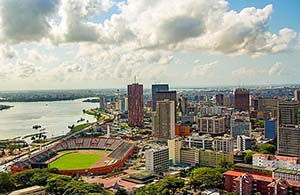CIMA’s birth and historical landmarks
 During the 19th century and until the 1960s, all the markets in the CIMA zone were monopolized by the subsidiaries and offices of foreign insurance companies, mainly French ones. The control of these sometimes-embryonic structures was entrusted to the parent companies based in Europe.
During the 19th century and until the 1960s, all the markets in the CIMA zone were monopolized by the subsidiaries and offices of foreign insurance companies, mainly French ones. The control of these sometimes-embryonic structures was entrusted to the parent companies based in Europe.
It was not until the 1960s and the independence of the countries in the region that companies under local law were set up. Sovereign States then collaborated with the French regulator to support their respective markets and preserve the proper functioning of the newly created insurance companies.
In July 1962, 14 States, that is, France and 13 African countries (Benin, Burkina Faso, Cameroon, Central African Republic, Congo, Côte d’Ivoire, Gabon, Mali, Niger, Senegal, Chad, Togo and Madagascar) signed an agreement creating the International Conference of Insurance Controls (CICA). The CICA is then domiciled in Paris. The aim of this new entity is to harmonize national legislations and regulations, to set up a corporate supervisory body and to train African executives for the insurance sector.
Read also | CIMA’s organization and role
Due to the poor management practices that had existed in the 1970s, the lack of economic buoyancy and the obstacles to national supervisory and control bodies, CICA was unfortunately unable to achieve the objectives set upon its inception.
This structural imbalance has affected the quality of the services offered, altering the economic role of insurance in the region.
In an effort to offset this situation, the CICA member countries embarked on a long process of transformation: signing new conventions, transfering the headquarters from Paris to Libreville (Gabon) in 1976, introducing a Council of Ministers of Insurance (CMA) and an Inter-State Insurance Control Commission in 1990.
It is at the end of this long process of transformation that the Inter-African Conference on Insurance Markets (CIMA) was born as a community structure.
The treaty establishing CIMA was signed on 10 July 1992 in Yaoundé (Cameroon) by 12 former members of CICA (Benin, Burkina Faso, Cameroon, Central African Republic, Congo, Côte d'Ivoire, Gabon, Mali, Niger, Senegal, Chad and Togo), joined by the Comoros and Equatorial Guinea.
Signed in 1992 but entered into force on 15 February 1995, the treaty organizing CIMA grants any African state the possibility of joining the new organization.
Year after year, the Inter-African Conference on Insurance Markets has been able to impose its authority on all the insurance companies of the organization’s 14 countries. Having become a successful example of regional cooperation, CIMA has not only established a real regulatory framework but has also imposed prudential norms in keeping with international standards.
CIMA: historical landmarks
- 27 July 1962Signature by 14 countries (Benin, Burkina, Cameroon, Central African Republic, Congo, Gabon, Mali, Niger, Senegal, Chad, Togo, Madagascar and France) of the convention creating the International Conference of Insurance Supervisors (CICA). The headquarters of the CICA is then set in Paris.
- 27 November 1973Signature by 12 countries without the participation of Madagascar, of a new convention replacing the previous one, with France now being granted the observer status.
- 1976Transfer of the CICA headquarters from Paris to Libreville (Gabon).
- 24 September 1981Establishment by the Member States of the International Conference of Insurance Supervisors of the Joint Reinsurance Company of CIMA Member States (CICA-RE) which started operating on 1 January 1984.
- 20 September 1990Signature by the CICA States of the Cooperation Agreement for the Promotion and Development of the Insurance Industry (CCDPIA) whose task is to remedy the difficulties of the CICA.
Establishment of a Council of Ministers of Insurance (CMA) and an Inter-State Commission for Insurance Supervision in the same year. - 25 April 1991Project for the establishment of an integrated organization of the insurance industry. This project was initiated by the Ministers of Finance of the Franc Zone, meeting in Ouagadougou, Burkina Faso.
- 10 July 1992Signature in Yaoundé, Cameroon, of the treaty establishing the Inter-African Conference on Insurance Markets (CIMA), a treaty signed by 13 member states: Benin, Burkina Faso, Cameroon, Central African Republic, Chad, Comoros, Côte d’Ivoire, Gabon, Equatorial Guinea, Mali, Niger, Senegal and Togo.
- 15 February 1995Entry into force of the CIMA Treaty, enabling any other African State to join CIMA.
- 15 April 2002With Guinea Bissau joining CIMA, the number of member states rises from 13 to 14.

